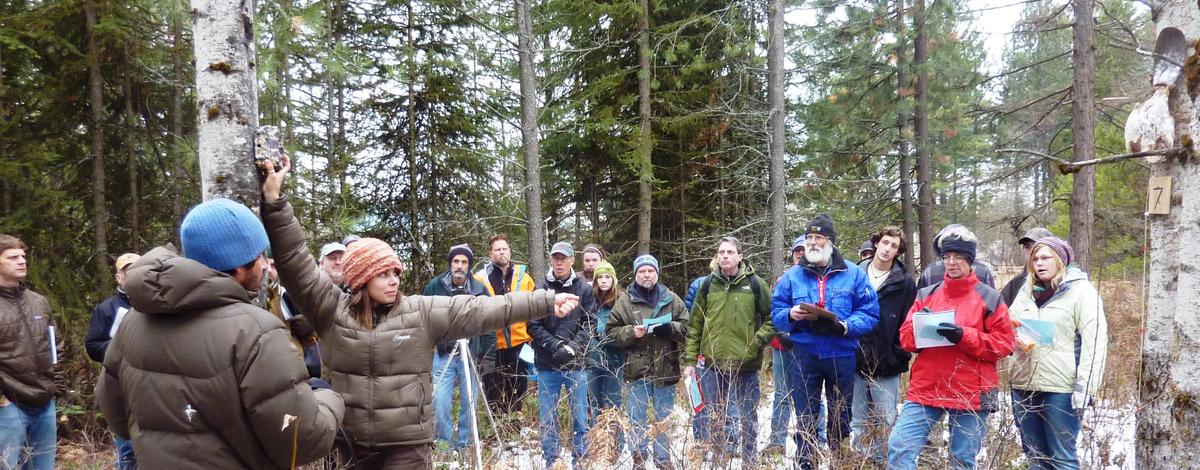The Multi-Species Baseline Initiative (MBI) is a collaborative of organizations that monitor wildlife and microclimate across the Idaho Panhandle and adjoining mountain ranges.

Target Species
From 2010-2014 MBI partners co-located microclimate data loggers with wildlife field surveys across the Idaho Panhandle and adjoining mountain ranges. Our surveys prioritized amphibians, terrestrial gastropods, and forest carnivores identified as 'lacking essential information' in Idaho or Washington 2005 State Wildlife Action Plans (SWAP). Our efficient multi-species surveys enabled the collection of standardized data for 182 species of plants and animals at 2,315 locations. We established micro-climate data loggers at 1,169 of those sites which collected air or water temperature data for 1-4 years. Over 500 people, including 200 volunteer citizen naturalists, contributed to this project. Our baseline dataset informed the 2015 SWAP revisions and is the beginning of a long term regional multi-taxa monitoring program.
Key Findings (2010-2014)
- Standardized surveys at 2,315 sites detected 182 species.
- From 2005 to 2015 the mean NatureServe Idaho subnational conservation status rank (S-rank) of target species increased by 1.4.
- From 2005-2015 our understanding of landscape level species occurrence changed for each of the 19 target SGCN.
- From 2005 to 2015 the mean Idaho S-rank of target invertebrate increased by 2.3.
- From 2005 to 2015 mean Idaho S-rank of target vertebrates decreased by 0.4.
- Invertebrate status tended to increase with additional survey effort and vertebrates either stayed the same or decreased slightly.
- Cryptomasitx mullani blandi: We provide evidence this trinomial should never have been considered a distinct taxonomic unit.
- Cryptomastix sanburni and Magnipelta mycophaga, both considered possibly extinct in 2005, were detected at multiple sites.
- Evidence supporting a new species of Hemphillia is provided.
- Wood frogs (Rana sylvatica) were never extant in Idaho.
- Northern leopard frogs (Rana lithobates) are native to northern Idaho and appear to be extirpated.
- Western toads (Anaxyrus boreas) within the study area are appropriately taxonomically classified.
- Western toads were more abundant in the Selkirks than other portions of the study area.
- Tiger salamanders (Ambystoma tigrinum) were likely never extant in the Idaho Panhandle.
- Chytrid fungus (Batrachochytrium dendrobatidis) is widespread at low concentrations across the study area.
- We detected 46 individual fishers (Pekania pennanti ) (25 males, 20 females, 1 unknown gender).
- Fishers are more abundant in the West Cabinet Mountains than the remainder of the study area.
- The 'native' fisher Haplotype 12 was not detected.
- 5 individual (2 males, 3 females) Canada lynx (Lynx canadensis) were detected.
- 3 individual male wolverines were detected.
- Arboreal mammal species richness, particularly American marten (Martes americana), is lowest in the Coeur d'Alene Mountains.
- Mean 2013 annual air temperature of survey sites in was 6.17°C.
- Mean 2013 annual wetland water temperature was 5.88°C.
- A cool air refugium is identified in the Selkirk Mountains.
- Four terrestrial gastropods are associate with cooler than average mean air temperatures.
- The majority of terrestrial gastropods are found across a wide range of mean air temperatures.
- Most target 'rare' terrestrial gastropods were relatively abundant with 4 of the 8 most commonly detected gastropods being target 'rare' species.

| AMPHIBIANS | |
| Wood Frog | Rana sylvatica |
| Northern Leopard Frog | Rana pipiens |
| Tiger Salamander | Ambystoma tigrinum |
| Western Toad | Anaxyrus boreas |
| GASTROPODS (slugs & snails) | |
| An Oregonian | Cryptomastix mullani blandi |
| Fir Pinwheel | Radiodiscus abietum |
| Humped Coin | Polygyrella polygyrella |
| Kingston Oregonian | Cryptomastix sanburni |
| Lyre Mantleslug | Udosarx lyrata |
| Magnum Mantleslug | Magnipelta mycophaga |
| Pale Jumping Slug | Hemphillia camelus |
| Sheathed Slug | Zacoleus idahoensis |
| Thinlip Tightcoil | Pristiloma idahoense |
| Blue-grey Taildropper | Prophysaon coeruleum |
| Smoky Taildropper | Prophysaon humile |
| MAMMALS | |
| Fisher | Pekania pennanti |
| Canada Lynx | Lynx canadensis |
| Wolverine | Gulo gulo |
Partner Organizations
- British Columbia Ministry of Forests, Lands, and Natural Resource Operations
- Bureau of Land Management
- Coeur d'Alene Tribe of Indians
- Friends of Scotchman Peaks Wilderness
- Hancock Forest Management
- Idaho Conservation League
- Idaho Department of Lands
- Idaho Department of Fish and Game
- Kalispel Tribe of Indians
- Idaho Office of Species Conservation
- Idaho Panhandle National Forest
- Potlatch Corporation
- Selkirk Outdoor Leadership and Education
- University of Idaho
- University of Washington Climate Impacts Group
- US Fish and Wildlife Service
- US Forest Service Rocky Mountain Research Station
- Washington Department of Fish and Wildlife

